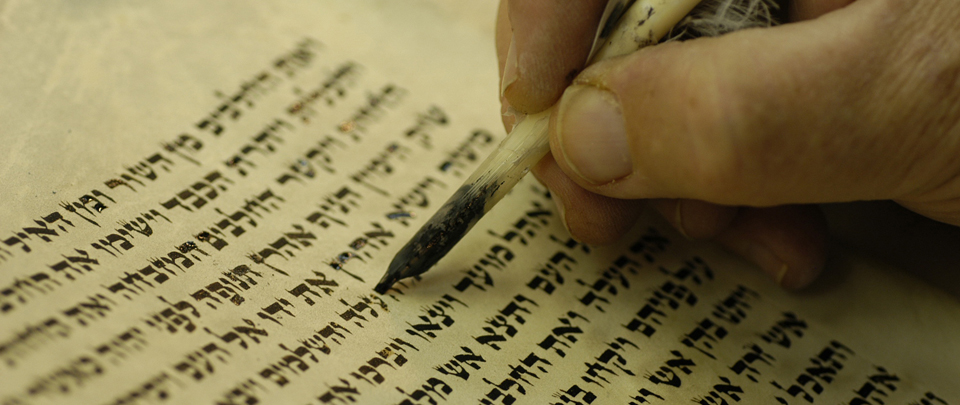
Volume 19, Issue 10 (March 5, 2017)
God’s Covenant with Israel
How the Bible Came to Us (4)
By Kyle Pope
Years ago, I belonged to a book club. Once a month, a book was sent to all members of the club. That allowed each of us to build up a complete set of some series of books as time went on. The Bible is not just one book—it is a collection of books revealed over a period of fifteen centuries. How did these books come into the collection of books we now have? In this study, we will look at the process that brought us the first books of the Bible.

The Old Testament
The term “Old Testament” identifies the first thirty-nine books of the Bible. They were revealed during a period spanning from around 1400 BC to 400 BC. These books were written by inspired authors of vastly different backgrounds and experiences. Some were kings and some were shepherds. Some were wealthy; others were former slaves and captives. Yet, all of these books form a united message because they all came from a divine source.
The Old Testament focuses upon God’s efforts to establish a special relationship with the family of a man named Jacob (whom God called Israel). The grandson of Abraham, Jacob had shown great faith in obeying God’s commands no matter how difficult they were. From this family God would build a nation through whom, ultimately, Jesus Christ would come into the world. The Old Testament deals with the background of this family, the laws and covenants God made with them as a nation, and their history of faithfulness and unfaithfulness leading up to the time when Jesus would come.
Key Events in the Formation of the Old Testament
To understand how these thirty-nine books came together, we must consider three important events:
1. The Giving of the Law of Moses. Jacob’s descendents developed into a nation while sojourning in Egypt. When God brought them out of Egyptian captivity, He gave His first known written revelation to Moses, the man He chose to lead the Israelites. In the last book of the Old Testament, God commanded, “Remember the Law of Moses, My servant, which I commanded him in Horeb for all Israel, with the statutes and judgments” (Mal. 4:4, NKJV). We noticed in our last lesson that some of this Law was written on stone (Exod. 24:12). On two stone tablets, God Himself wrote the Ten Commandments (Exod. 34:1, 28; Deut. 10:2, 4), but that wasn’t all that God revealed to Moses. The Law of Moses is five books, sometimes called the Pentateuch (meaning in Greek “five scrolls”). The first, the book of Genesis, revealed to Moses all that had occurred before his time, from Creation until Jacob’s family came to Egypt. The next four record God’s dealings with the nation of Israel after leaving Egypt and the laws that He gave to them. These books form the “Law of Moses” and are called “the law” (see Gal. 4:21-22 [in quoting Genesis]; Rom. 7:7 [in quoting Exodus]; Rom. 10:5 [in quoting Leviticus]; 1 Cor. 9:9 [in quoting Deuteronomy]).
While the Bible clearly affirms that these books were written by Moses and inspired by God, since at least the 19th century some scholars have rejected this. A German professor named Julius Wellhausen, who was heavily influenced by Darwin’s theories of evolution, developed the “Documentary Hypothesis.” He argued that the Pentateuch was pieced together long after the time of Moses from separate sources he labeled: (1) The J Source (texts he imagined that first referred to God only as Jehovah); (2) The E Source (texts he imagined that only referred to God with the Hebrew word Elohim); (3) The D (“Deuteronomistic” ) Source; and (4) The P (“Priestly”) Source. Although this view is widely taught in many universities, there is no evidence to support it. There are no manuscripts of these imagined J, E, D, or P sources. In fact, these different names for God are found side-by-side forty-seven times in the Pentateuch and together in the same verse 413 times! This would be highly unlikely if these documents were pieced together from earlier sources. Later books of the Bible affirm that Moses wrote the Law (Neh. 8:1; Mal. 4:4; Mark 12:26; John 1:17; 7:19). Ancient writers claimed that Moses wrote the Law (see Josephus, Against Apion, Book 1.8.1; 26.4). This theory is nothing more than an attempt to explain away the Bible’s claim that it comes from God.
2. The Recovery of the Law by Josiah. We discussed in our second study the example of God’s preservation of His word in the days of Josiah. During that time the Israelites in Judah had become so wicked they had actually lost the “Book of the Law.” The Bible tells us as the temple was being cleared, “Then Hilkiah the high priest said to Shaphan the scribe, ‘I have found the Book of the Law in the house of the Lord.’ And Hilkiah gave the book to Shaphan, and he read it” (2 Kings 22:8). Remember this was long before printing presses, much less high-speed printers and copiers. The common people usually couldn’t afford books. All written documents were produced by hand and, thus, very expensive. Was this the only remaining copy of the Law? We aren’t told for sure, but what is clear is that it hadn’t been read in a long time or followed in daily life. As it was brought to the king, read before him, Josiah was deeply saddened when he realized how far his nation had turned away from God (2 Chron. 34:19-21).
What was this “Book of the Law”? Was this one book out of the Pentateuch or did it include all five? After the first five books of the Bible this phrase is used often (Josh. 1:8; 8:31, 34; 22:11; 2 Kings 22:8, 11; 2 Chron. 17:9; 34:14; Neh. 8:1, 3, 18; 9:3; Gal. 3:10), but Scripture never speaks of the “books of the Law” even though (as we noted above) the books of the Pentateuch are called “the law” (Gal. 4:21-22; Rom. 7:7; 10:5; 1 Cor. 9:9). Therefore, this was likely either one scroll with all five books, or separate scrolls containing all five.
When Josiah learned what the Law taught he called all the people together and read it before them. Together with the leaders of the people, they all committed to follow the Law and restore true worship of God (2 Kings 23:1-3). Altars for idol worship were torn down and a major effort to turn the nation back to God began (2 Kings 23:4-25). Undoubtedly this involved efforts to circulate and collect Scriptures that had been revealed in the years prior to this. Unfortunately Josiah was the last faithful king in Judah before the nation fell to Babylon and was carried off into exile as punishment for its unfaithfulness. Without doubt, the diligent work of Josiah helped to prepare the remnant of the faithful to retain and preserve God’s word during the time of this exile.

3. The Restoration and Reforms of Ezra. As difficult as the exile would be, God revealed to the prophet Jeremiah that it would actually preserve the remnant of the faithful like a basket of “good figs” (Jer. 24:1-10). At the end of the exile the truth of this promise was realized. When faithful Israelites who have been removed from the land were allowed to return they showed themselves to be zealous to follow the word of God in all things. Among those who returned was a priest and scribe named Ezra. The Bible tells us, “Ezra had prepared his heart to seek the Law of the Lord, and to do it, and to teach statutes and ordinances in Israel” (Ezra 7:10). The Persian king Artaxerxes authorized Ezra to restore and teach worship and conduct in accordance with the Law of Moses (Ezra 7:12-25). Like Josiah, Ezra led both the returning exiles and the Jews who had remained in the land in a nationwide restoration of obedience to God’s word (Ezra 8:1-8). Ezra (the scribe) and Nehemiah (the governor) were both inspired to write books during this period and appear to have done much to circulate and preserve the books of Scripture that had been revealed to that point.
While a few other prophets came after this, the reformation of Ezra was the final major event involved in the formation of the Old Testament. Jews after that time called Ezra and the men with him who taught the people the “Great Assembly (or Synagogue).” The Jewish Mishnah, a collection of rabbinical teachings written after the New Testament reflecting Jewish traditions over several centuries, claimed, “Moses received the Torah (i.e. the Hebrew word for “Law”) on Sinai, and handed it down to Joshua; Joshua to the elders; the elders to the prophets; and the prophets handed it down to the Men of the Great Assembly” (Perke Aboth 1).
In our next lesson we will consider some questions regarding what distinguishes books inspired by God that properly constitute Old Testament books from other uninspired texts that came before the New Testament.

